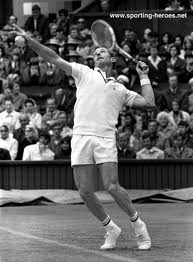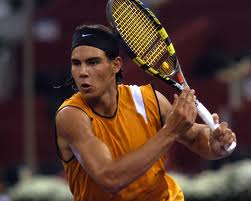As Rafa Nadal wins his eleventh grand slam, how does he rank against the other all time greats that have won as many or more Grand Slams. Those would be Roger Federer (16), Pete Sampras (14), Bjorn Borg (11) and Roy Emerson (12).
But wait a second, who is Roy Emerson?!? Roy Emerson, Emmo, was an Australian amateur tennis player who is renowned for winning many of the amateur Grand Slam championships in the era just preceding the Open Grand Slams.
From 1920 to 1950 the United States won the Amateur Only Davis Cup 13 times and finished second 9 times. In that same period, Australia won 2 Davis Cup titles and finished second 10 times. (Davis Cup Titlists – http://bit.ly/OuRtOL ). In the late 1940s, Jack Kramer joined and developed the men’s professional tennis circuit.
Quickly the greatest players of the game joined the tour. Any players who had amateur grand slam success went to the next level of play, the pro circuit and Kramer’s championship tour. The US Pro Championships were considered to be the “Pro Grand Slam”
From 1948 through 1954 more than 95% of the quarterfinalists at the US Pro Championships were Americans. The Australians won the Davis Cup from 1950-1953 as the top 8 Americans were playing pro tennis. Frank Sedgman was the first Australian to have an impact on the pro circuit reaching the finals of the US Pro in 1954. He was quickly joined by Ken Rosewall and Lew Hoad, but Pancho Gonzalez dominated the championships, winning from 1952 to 1959. Americans still comprised more than 75% of semifinalists at the US Pros from 1955-1962 but Australia won the amateur Davis Cup until Rod Laver turned pro. (US Pro Draws for the 1960’s http://bit.ly/NbbQ6K ). The next year, despite Emmo’s wins in Australia and Roland Garros, the Australians lost the Davis Cup to the United States with Marty Riessen, Dennis Ralston and Arthur Ashe winning the amateur team championship.
Australia adopted a hard line. The Lawn Tennis Association of Australia (LTAA) provided a rich “stipend” for their “amateur” players to keep them amateur. From 1963 to 1966 no new Australians turned pro and qualified into the US Pro Championships and finally in 1967, Fred Stolle turned pro after winning the 1966 US Amateurs despite having a worse Slam record than Emmo.
In the period from 1963 to 1966, Emmo won 10 of his 12 slams. From 1963 – 1965, American amateurs had no budget to travel. More than 80% of top 8 Australian Amateur championship seeds were Australians while at the same time, more than 50% of US Pro quarterfinalists were American. (1963 Australian Open Seeds – http://bit.ly/MBwKGo)
Finally, in 1969, all the amateur championships converted to professional and Rod Laver, the professional champion 3 of the prior 4 years won the Grand Slam again. Emerson never got beyond a quarterfinal of any slams in the pro era, losing in the quarterfinals as defending champion of Roland Garros to the 40 year old Pancho Gonzalez. Jack Kramer in 1979 did not rank Emerson in his list of the top 21 players of all time (http://bit.ly/L3AmUG)
Philosophically we like to consider Emmo’s position in the tennis pantheon. As an amateur during a settled pro era, we have never seen a period where amateurs in any sports are better than the pros. Think about the difference between the US Amateur Olympic basketball team and the Dream Team.
As you know, this blog looks at the hard data and real history of tennis and fixes the data so people can do apples to apples comparisons of tennis quality. When head to head data is not available, we substitute other data such as common opponents or competition during different eras.
For the decade of the 1960s there is no way to rank Emmo against his peer group during that period since he did not play any of them for long periods. However, we can rank him post amateur as a professional against the same players who are about the same age. In the pro era, Emmo had a Won/Loss record of 5-34 against the top pros from 1963-1967 including Arthur Ashe who turned pro in 1969 and was 11-1 against Emmo as a pro though he lost two Amateur Australian finals to Emmo.
Roy Emerson record vs. the top pros of 1963-1967, post 1967
W/L
Rod Laver 1-14
Ken Rosewall 1-5
Pancho Gonzalez 0-1
Andres Gimeno 2-3
Arthur Ashe 1-11
Overall Record 5-34
Given this record, we would put Emerson’s highest rank among amateur / pros of the 60’s who were his age outside of the top 5.
Yet Emerson remains in the top 10 players of many “experts” who don’t know the data or the circumstance of the time or willfully choose to ignore the data. If you google Roy Emerson and top 10 players of all time, more than 240,000 results occur. Yet, Pancho Gonzalez, who won a record 8 US Pro championships in a row, is not ranked as high by many experts as Emerson.
How do you reply to someone over beers who says Roy Emerson is a top 10 player of all time? You smile, you say,
* “He was a great amateur champion”,
* “He never got past a professional grand slam quarterfinal”,
* “He was 5-34 against the best pro players of his era”,
* “If he wasn’t the best of any of his years, how could he be one of the best of all time?”
And then you drink your beer very slowly.







